Discover 35 hidden attractions, cool sights, and unusual things to do in Freiburg (Germany). Don't miss out on these must-see attractions: Freiburg Minster, Schauinsland, and Flückigersee. Also, be sure to include Historisches Kaufhaus in your itinerary.
Below, you can find the list of the most amazing places you should visit in Freiburg (Baden-Württemberg).
Table of Contents
Freiburg Minster
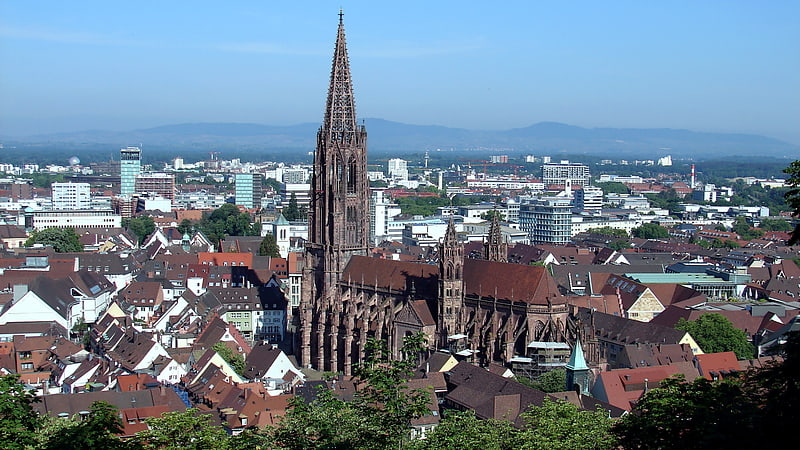
Also known as: Freiburger Münster
Grand cathedral with unique Gothic tower. Freiburg Minster is the cathedral of Freiburg im Breisgau, southwest Germany. The last duke of Zähringen had started the building around 1200 in romanesque style. The construction continued in 1230 in Gothic style. The minster was partly built on the foundations of an original church that had been there from the beginning of Freiburg, in 1120.
In the Middle Ages, Freiburg lay in the Diocese of Konstanz. In 1827, Freiburg Minster became the seat of the newly erected Catholic Archdiocese of Freiburg, and thus a cathedral.[1]
Address: Münsterplatz 1, 79098 Freiburg im Breisgau (Mitte)
Schauinsland

Historic mountain with a lookout tower. The Schauinsland is a mountain in the Black Forest with an elevation of 1,284 m above sea level. It is a popular destination for day trips. Due to the high amount of silver mining, it was previously known as "Erzkasten"; the name "Schouwesland" first appeared in 1347. The mountain is located roughly ten kilometres south-east of Freiburg’s city centre.[2]
Flückigersee

Lake in Germany. The Flückigersee is a 10-hectare lake in the Freiburg district of Betzenhausen.
It developed from the quarrying of sand and gravel by the Flückiger construction company in the 1920s.
The mining at the lake was stopped in 1983, because the surrounding area became more and more inhabited. In 1986 the lake became part of the Landesgartenschau exhibition (an exhibition in the local area), today's Seepark.
In the year 2000 the lake's deepest point was about 25 metres. The water quality is generally good, but tiny parasitic worms called cercaria live in the lake, which can cause cercarial dermatitis. They are commonly known as swimmer's itch after being in water.
In 1999, when the city of Freiburg investigated the water quality of municipal lakes that had previously been quarried in, a strong eutrophication was found especially in the Flückigersee. As a result, the citizen and student project Flückiger See (German: Bürger- und Schülerprojekt Flückiger See) was founded at the Freiburg Eco-Station for environmental education, in order to preserve the lake.
In order to combat the overpopulation of up to 40 swans, a pair of swans were fed special food as part of the Alphaschwäne (English: Alpha Swan) project. Since 2001, the territorial behaviour of these strengthened swans has kept the lake free from outsider swans.
In 2002, a limnological office was commissioned to collect the ecological key data on the lake. A local council decision led to the results being published. They state that the main reason for the nutrient pollution is an increased phosphorus content caused by inflowing groundwater. The phosphorus probably originates from debris that was dumped into the lake after the bomb attack on Freiburg during the Second World War and the debris contained remains of phosphorus bombs, 255 tonnes of which were used during the attack. The lake used to be further to the East, in the same place where the track used to move debris after the War ended.
In 1997 and 2001 the lake was cleared of rubbish and debris by volunteers. In the summer of 2013, a diving school from Ringsheim and members of the Sea Shepherd initiated a similar clear up. The clearing also attempted to capture some of the 200 or so turtles now living in the lake (mainly red-cheeked and yellow-bellied turtles). However, they only caught two turtles. The turtles are abandoned domestic animals whose high life expectancy and food requirements endanger the ecosystem of the lake.[3]
Historisches Kaufhaus
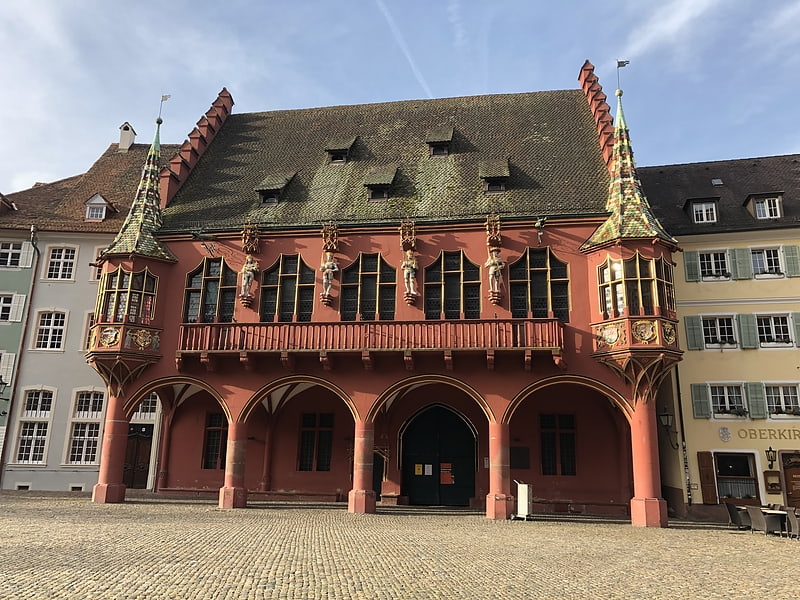
Event venue in Freiburg im Breisgau, Germany. The Historical Merchants' Hall is one of the most outstanding buildings in Freiburg im Breisgau. It is situated on the south side of the Minster Square. It stands out clearly due to its dominant red facade.[4]
Address: Muensterplatz 24, 79098 Freiburg im Breisgau (Mitte)
Augustinermuseum

Art museum in a former monastery church. The Augustiner Museum is a museum in Freiburg im Breisgau, Germany located in the former Augustinian Monastery building. It is undergoing an extensive renovation and expansion, the first phase of which ended in 2010.[5]
Address: Gerberau 15, 79098 Freiburg im Breisgau (Mitte)
Wiwilíbrücke
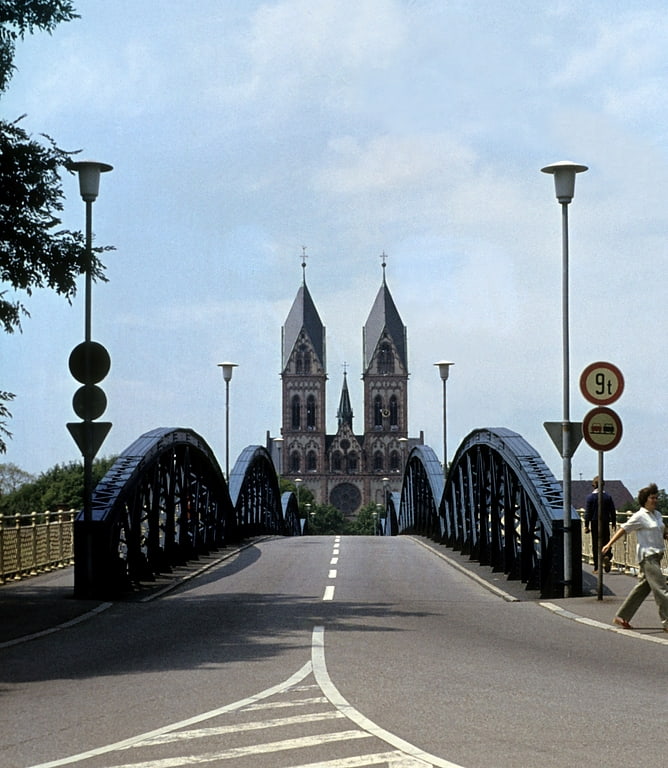
Truss bridge in Freiburg im Breisgau, Germany. Wiwilíbrücke is a bridge of the German city Freiburg im Breisgau which is also called Blaue Brücke because of its paint and it had formerly been called Stühlingerbücke before the new Stühlingerbücke was built for the tramway. The bridge connects the city’s district Stühlinger to the old town as it links the church square of Herz-Jesu-Kirche to Konrad-Adenauer-Platz in spanning the railway tracks of Freiburg Hauptbahnhof. Today, Wiwilíbrücke is a listed building and is used by up to 10,000 cyclists per day.[6]
Address: Wentzingerstr. 15, 79106 Freiburg im Breisgau (Mitte)
Old Cemetery
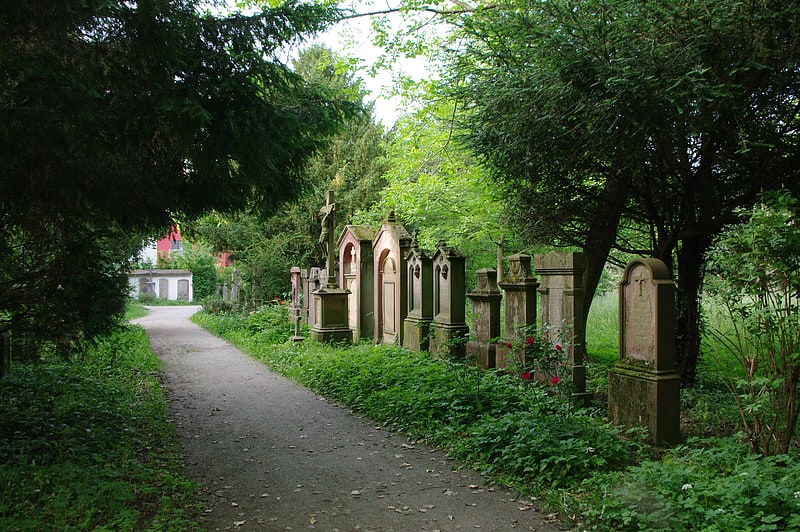
Cemetery in Freiburg im Breisgau, Germany. The old cemetery in Neuburg, a district of Freiburg im Breisgau, Germany, covers an area of 2.65 hectares. Situated on park-like grounds, the old cemetery is one of Germany’s oldest cemeteries that have been abandoned and preserved as a whole. Located close to the Ludwigskirche, it is often mistaken to be part of the neighboring district Herdern. Providing tombs to an estimate of 1200 people, half of them are worthy of preservation. The booster club takes care of maintenance. The old cemetery falls under preservation order of cultural and natural monument. Moreover, it can be seen as evidence for death cult, town history and stylistic area of the 17th and 18th century. Serving not only as a place for individual and artistic tombstones of middle class people. Furthermore, the old cemetery grants an insight into the consciousness of faith during the baroque period until the time of neo-classicism.[7]
Schwarzwald-Stadion
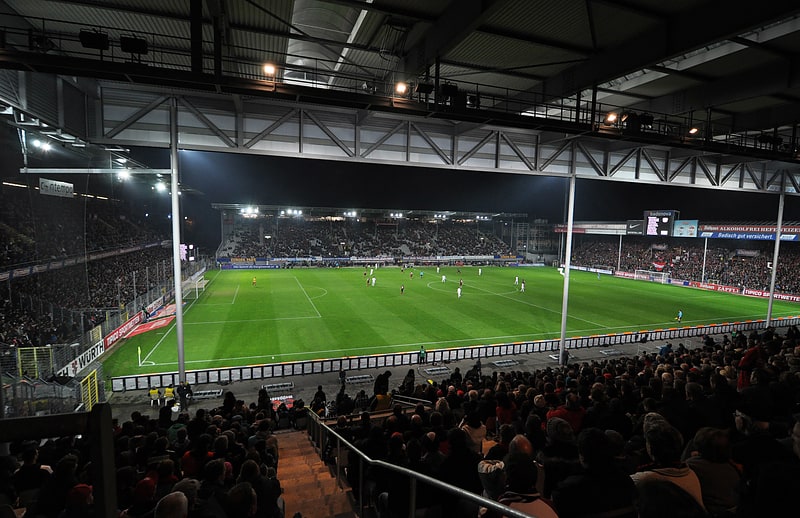
Stadium in Freiburg im Breisgau, Germany. Dreisamstadion is a football stadium in Freiburg, Baden-Württemberg, Germany. It was formerly the home of Bundesliga team SC Freiburg between 1954 and 2021, until a new stadium — the SC-Stadion — was built in October 2021. The stadium holds 24,000 spectators and was built in 1953. It is situated near the Dreisam river, for which it is named.
In June 2004 it was given the name of Badenova-Stadion, later Mage Solar Stadion, and for a short time the Stadion an der Schwarzwaldstraße. Due to a sponsorship deal, it was most recently named the Schwarzwald-Stadion.
In 2012, modernising the stadium was deemed unprofitable. In February 2015, a referendum was held to determine whether a new stadium should be built and if so, where. The citizens of Freiburg voted in favour of the construction of a new stadium, SC-Stadion, with a capacity of 34,700 at the Wolfswinkel nearby Freiburg's municipal airport. The move to the new stadium is scheduled for the start of the 2021–22 season.[8]
Address: Schwarzwaldstraße 193, 79117 Freiburg im Breisgau (Ost)
Stadtgarten Freiburg

Also known as: Stadtgarten
Park in Freiburg im Breisgau, Germany. The Stadtgarten of Freiburg is a 2.6 ha park within the Neuburg district. It has an old tree grove and a large rose garden, and lies between the Leopoldring, Jackob Burckhardt, Ludwig and Mozart streets near Freiburg's city centre. It is connected to Karlsplatz via the Karlssteg footbridge, which is made from pre-stressed concrete. Since 2008 the Schlossberg Tram, an inclined elevator, leads up to Schlossberg. It replaced the Schlossberg Cable Car built in 1968.
The music pavilion in the park is used during summer for concerts and as a free-lance stage. The Theatresports open-air-festival has taken place in the Stadtgarten pavilion since 1997. In addition to perennial and interspersed pines, the garden includes a children’s playground as well as two ponds and wells. The Stadtgarten also held the Schlossbergfest, which was held once a year during the summer, with several thousand candles burning in the city garden and on the Schlossberg. It took place for the last time in 2011.[9]
Stühlinger Bridge
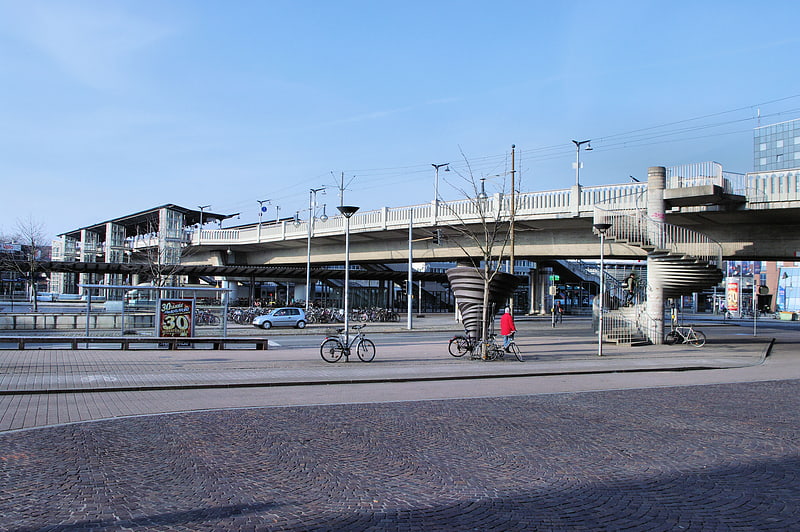
The Stühlinger bridge was made of prestressed concrete for tramways, pedestrians and cyclists in Freiburg im Breisgau. It connects the Bertoldstraße with the Wannerstraße. In doing so, it crosses the Bismarckallee, the central bus station, the main railway station Hauptbahnhof, the Wetzingerstraße and the Stühlinger Church Square. The right short individual sections make it seem like an inner-city viaduct or an elevated highway in proportion to the whole length.
The Sühlinger bridge fulfills simultaneously three functions: it connects the Old City district with the Stühlinger district, it is used as a tramway station and as a pedestrian bridge overcrossing the main railway station and gives access to the railway platforms.
Since 2009, the bridge needs rehabilitation because water infiltrates the concrete. As soon as the rehabilitation is carried out, the cyclists are not allowed to use the bridge anymore and have to use the neighboring Wiwilí Bridge as an alternative one. The reason for this is the height of the guardrails of the bridge, which only rise up to 1,00 meter instead of the latterly legal required 1,20 meters. With the start of the rehabilitation, the hitherto grandfather clause runs out and the regulation is obligatory. The rehabilitation initially planned for 2012 was deferred until August 2012 because of delays and call for bids. Since they were still at the call for bids in the year 2013, it was not possible to make a statement about when it would be rehabilitated in November 2013. Now the rehabilitation is supposed to start in the spring 2019.
In the autumn 2013 the spiral stairs leading to the Freiburg Konzerthaus were underpinned with wood. Because of budget shortage of the civil engineering department of Freiburg in November 2013, it was decided to call for bids in autumn 2015 and that the rehabilitation of the stairs will start in the spring 2016. In the spring of 2016 they thought that the reparations could start at the earliest in the autumn 2017.[10]
Konzerthaus Freiburg
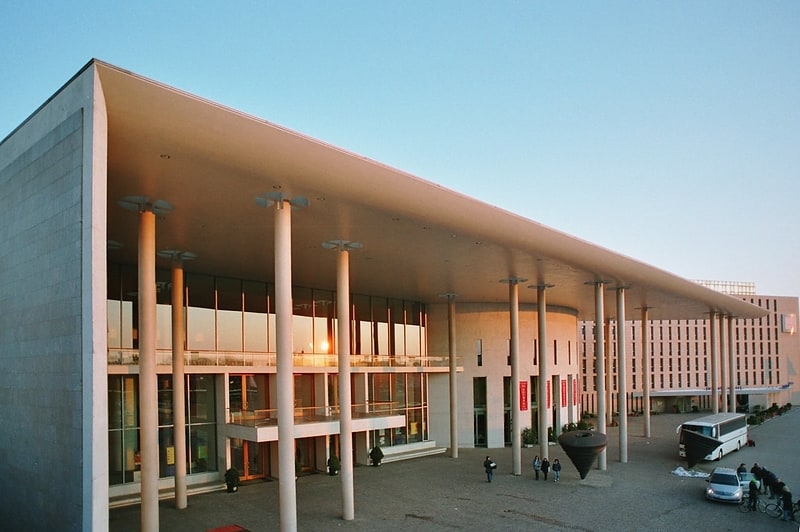
Event venue in Freiburg im Breisgau, Germany. The Freiburg Konzerthaus is a concert hall in Freiburg im Breisgau, Germany, that was opened to the public in 1996. Based on plans by architect Dietrich Bangert, the building is used for concerts and performances, as well as conventions and meetings. Under the working title "Cultural Event and Conference Location", it was one of the most controversial building projects in Freiburg since the end of World War II. Until 2016, it served as the headquarters of the Southwest German Radio Symphony Orchestra. With its multiuse great hall, it serves as a venue for a range of diverse events.[11]
Address: Konrad-Adenauer-Platz 2, 79098 Freiburg im Breisgau (Mitte)
Seepark Betzenhausen

Park in Freiburg im Breisgau, Germany. The Seepark is a park in the district Betzenhausen of Freiburg im Breisgau which was constructed for the Landesgartenschau in 1986. It is a local recreation area, covering 35 hectares, and contains the Flückigersee, an artificial lake which takes up about 10 hectares. In the northeastern part of the park is the 15-meter tall Seepark Tower.
The area now taken up by the Seepark used to be used for agriculture. However, the soil was not well-suited for growing good grain. In the 1920s, the company Flückiger started removing sand and gravel from the grounds. In the 1970s, Flückiger's operation ended, in order for the area to be used as a parking lot.
In 1986, the successful application to hold the Landesgartenschau in Freiburg led to the redesign of the grounds, leaving the park in its current form. The Landesgartenschau had roughly two million visitors.
In 1990, the park was expanded to include a 3600 m² Japanese garden to the West of the park, as part of a partnership with the Japanese city Matsuyama.
In the eastern part of the park is a rose garden, which was added in 2011. It was named the Eugen Martin Anlage after the founder and citizen of honor, Eugen Theodor Martin.[12]
Möslestadion

Stadium in Freiburg im Breisgau, Germany. The Möslestadion is a soccer stadium in Freiburg im Breisgau. The stadium used to be home to the Freiburger FC. Today it is used by the second men's team and the Freiburg soccer school of the SC Freiburg. Since the 2008/09 season, the stadium has also been used for the SC Freiburg women's team.
The stadium can hold about 5,400 spectators. A standing section wraps around the south, east, and west sides of the pitch, and a second standing section is located on the north side. Above the standing section to the south of the pitch are 1000 sheltered seats. The standing sections on the east and west sides behind the goals are closed.[13]
Church of St. John
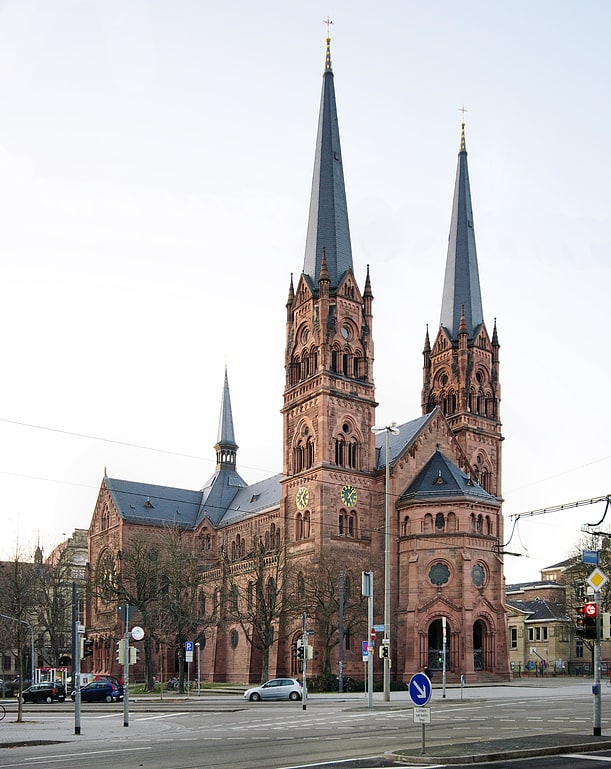
Also known as: St. Johann
Catholic church in Freiburg im Breisgau, Germany. The Johanneskirche is a catholic church located in Freiburg im Breisgau. It was first opened in 1899 and is currently located in the Wiehre district. Around the church, further historic buildings were built. On the western side is the presbytery of the community next to a vocational school and to the north is the Lessingschule. At the same time as the Johanneskirche was being completed, the Protestant Christians built their own church near to Johanneskirche, the Christuskirche.[14]
Address: Kirchstraße 4, 79100 Freiburg im Breisgau (Süd)
Freiburg Botanical Garden
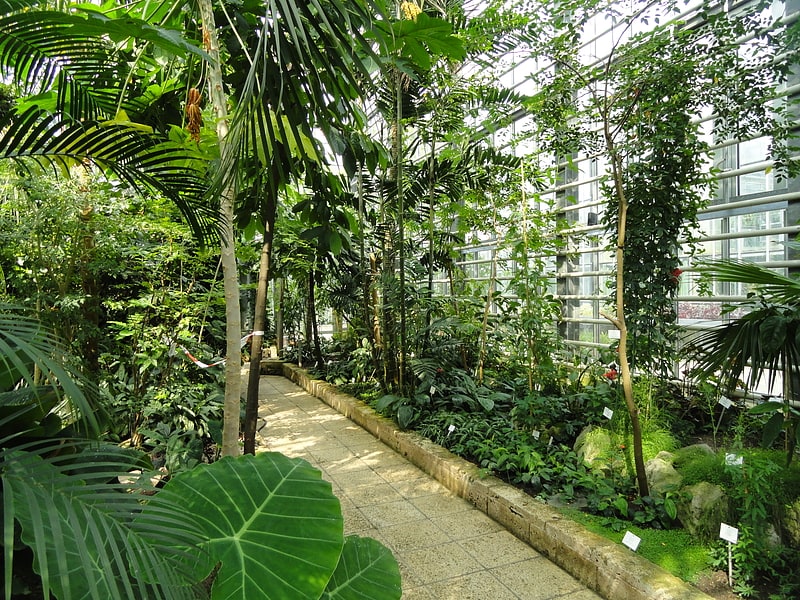
Also known as: Botanischer Garten Freiburg
Botanical garden in Freiburg im Breisgau, Germany. Freiburg Botanical Garden is a botanical garden in the Herdern district at Schänzlestraße 1, Freiburg im Breisgau, Baden-Württemberg, Germany and is associated with the University of Freiburg as the "Forschungs- und Lehrgarten der Universität Freiburg" of the Faculty of Biology. The current director of the garden is Professor Dr. Thomas Speck.
The garden was founded in 1620 by the University of Freiburg. A building on the same property was rebuilt as a hospital for members of the university, which also served for anatomy training. It was one of the first botanical gardens in Germany. The garden was originally part of the University of Freiburg Faculty of Medicine. The first director of the garden was Jacobus Walter (born 1655), a professor of medicine who was also responsible for botany. During the Thirty Years' War, the garden was destroyed.
The garden was rebuilt in 1766, but was forced to relocate to make room for the fortifications built by the Marquis de Vauban to protect the city after Freiburg had been annexed by France in 1677. The botanic garden was laid out near the river Dreisam. Its design was heavily influenced by the onset of the Age of Enlightenment and by the increased interest in botany during the second half of the 18th century. Again part of the Faculty of Medicine, the garden measured approximately 6.6 acres (27,000 m2) in area. Despite damage from floods and the Napoleonic Wars, the garden included an impressive 3,000 plants by 1829, as well as greenhouses built in 1827 and 1828. Directors of the botanical garden from this period included Karl Julius Perleb, Fridolin Karl Leopold Spenner, Alexander Braun, Carl Wilhelm von Nägeli, Heinrich Anton de Bary and Julius von Sachs.
In 1878 the garden at the Dreisam had to be abandoned, and the garden relocated to what is now the Institutsviertel (institutes quarter) and remained at this location until the First World War. In 1912 the garden moved to its current location in Herdern district of Freiburg, when a new institute for botany was built there. The garden sustained damage during World War II in the 1944 air raid on Freiburg.
Today the garden contains some 8,000 species, with research centered upon Black Forest fossil flora of the Carboniferous period, and the functional morphology and biomechanics of living and fossil plants. Its collections include plants from alpine regions, dunes, heaths, marshes, and bogs, with four exhibition greenhouses (900 m²) containing tropical plants, ferns, and cacti and succulents.[15]
Address: Schänzlestr. 1, 79104 Freiburg im Breisgau (Nord)
Martinstor

Historical landmark in Freiburg im Breisgau, Germany. The Martinstor, a former town fortification on Kaiser-Joseph-Straße, is the older of the two gates of Freiburg im Breisgau that have been preserved since medieval times. Both gates, the Martinstor and the Schwabentor, are located in the city centre. In medieval times the Martinstor was also known as Norsinger Tor.[16]
Schwabentor

Iconic, medieval city gate with a museum. The Schwabentor, also called Obertor in the Middle Ages, is the more recent of the two remaining city gates of the medieval defensive wall of Freiburg im Breisgau in Baden-Württemberg, Germany.[17]
Address: Oberlinden 25, 79098 Freiburg im Breisgau (Mitte)
Bertoldsbrunnen

Sculpture by Nikolaus Röslmeir. The Bertoldsbrunnen is a monument in the historic city of Freiburg im Breisgau. It is situated at the crossing of the Salz- and Bertoldsstraße with the Kaiser-Joseph-Straße. The fountain is one of the central locations of the city. A tram station with the same name is situated at the Bertoldsbrunnen where four of the five tramways of the Freiburger Verkehrs AG stop.[18]
Address: Bertoldstr. 45, Freiburg (Mitte)
Zinnfigurenklause
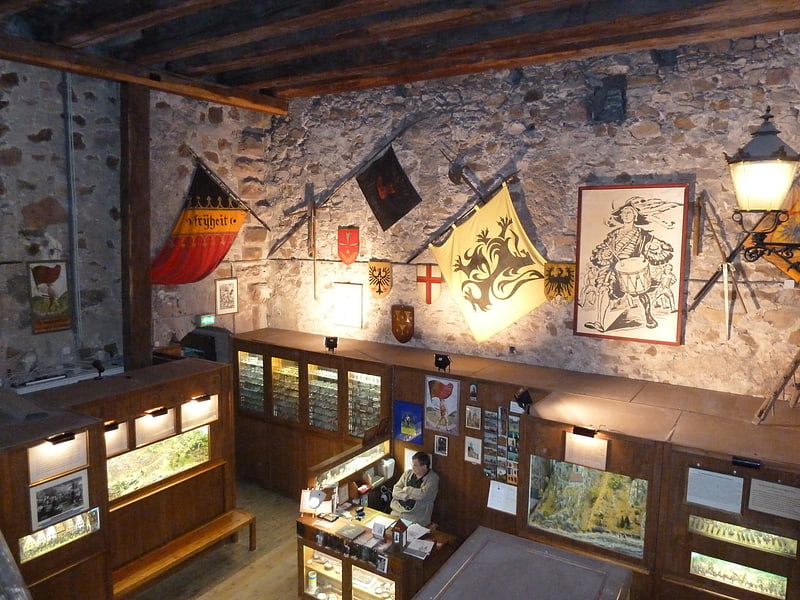
Museum in Freiburg im Breisgau, Germany. The Zinnfigurenklause is a private museum in Freiburg im Breisgau that depicts the history of the Schwabentor in south-eastern Germany.[19]
Schlossbergturm
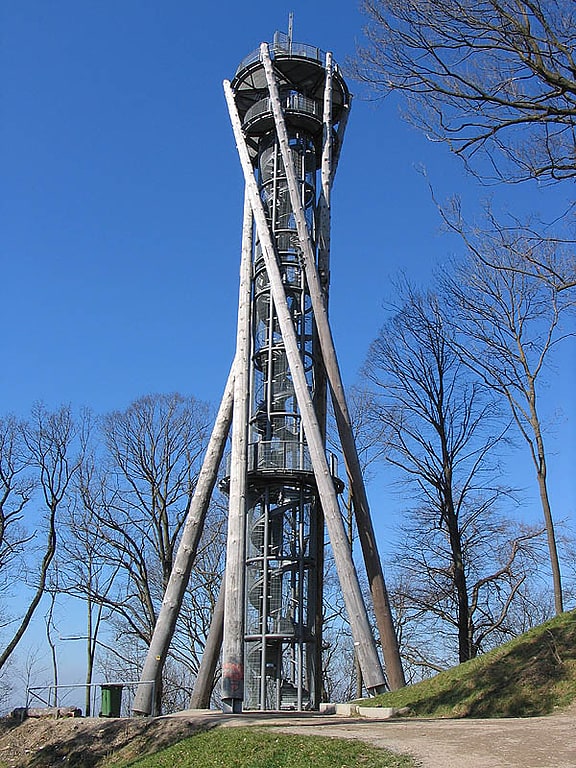
Tourist attraction in Freiburg im Breisgau, Germany. The Schlossbergturm or Castle Hill Tower is a 35 m high observation tower on Castle Hill Schlossberg on the edge of the historic Altstadt of Freiburg im Breisgau. It has 153 steps, its top is located 463 m above sea level and thus 185 m above the average altitude of the city. The tower's twisted design includes six tree trunks around a staircase made of steel. It has three platforms and the top is reached by a small spiral staircase. The tower offers a panoramic view of Freiburg and its surroundings.
The tower is built on the grounds of the Fort de l'Aigle von Auban, also known locally as "Salzbüchsle", which are a continuation of the Black Forest into the city of Freiburg. It was designed by local Freiburg architect Hubert Horbach for the Kuratorium Freiburger Schlossberg, and built in 2002.
It was funded in part by donations. For each donor a plaque with his or her name was attached to the vertical part of a step so that when climbing the tower one can read the names of the donors.[20]
Address: Am Schlossberg, Freiburg (Mitte)
Roßkopf
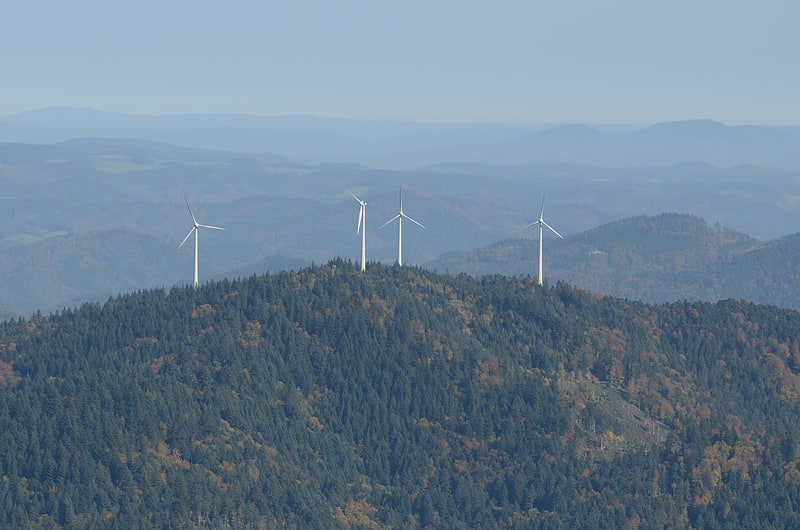
Scenic peak with trails and a summit tower. Roßkopf is a mountain of Baden-Württemberg, Germany.
The 737 m (2418 ft) high Rosskopf is a mountain in the Black Forest in the northeast of Freiburg and the southeast of Gundelfingen. It is on the edge of the territory of the city between the Glotter valley and the Dreisam valley. On the Roßkopf the borders of Gundelfingen, Freiburg and the formerly independent municipality Ebnet (today Freiburg-Ebnet) meet. Several border stones in the forest give evidence of the development of the municipal boundaries.[21]
Siegesdenkmal
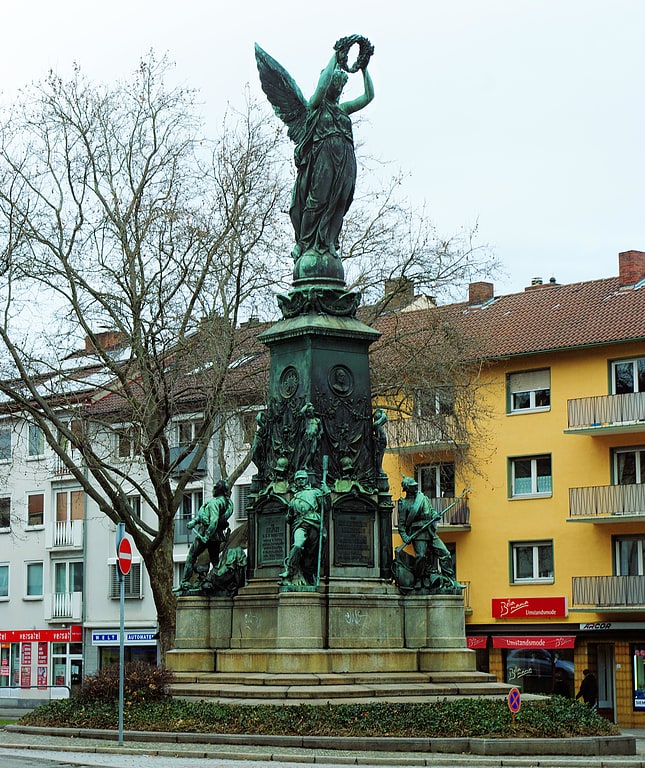
Historical landmark in Freiburg im Breisgau, Germany. The Siegesdenkmal in Freiburg im Breisgau is a monument to the German victory in the Franco-Prussian War in 1871. It was erected at the northern edge of the historic center of Freiburg im Breisgau next to the former Karlskaserne. After World War II it was moved 100m to the west. Today it is located on Europaplatz.[22]
Green spaces in Freiburg

Freiburg im Breisgau's parks, green spaces, recreational facilities, playgrounds, roadside greeneries and the Mundenhof add up to an area of 397 ha, which corresponds to 18.05 m2 of green space per Freiburg citizen. On average, major cities in Baden-Württemberg have 22.66 m2 green space/citizen. However, there is an area of 2600 ha of forest in the close proximity of Freiburg as well as additional recreational area like the Rieselfeld district. The majority of the green spaces came into existence from the 1960s on.[23]
Roßkopfturm
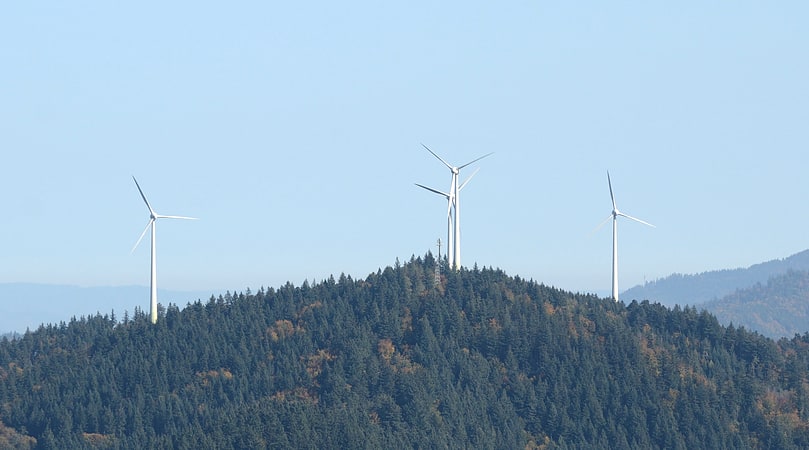
The Roßkopf tower is a 34.4 m high observation tower of steel frame structure commissioned and financed by the Schwarzwaldverein and built by the Freiburg architect Philipp Anton Lazy in 1889 on the 737 m high Roßkopf near Freiburg between the Dreisam valley and the Glotter valley.
It is one of the oldest steel lattice towers in Germany. Panoramic views of the Black Forest and the Rhine Valley can be seen from the observation platform above the treetops of the wooded hilltop, and in good visibility to the south until the Alps and the west the Kaiserstuhl and the Vosges.[24]
Schönberg
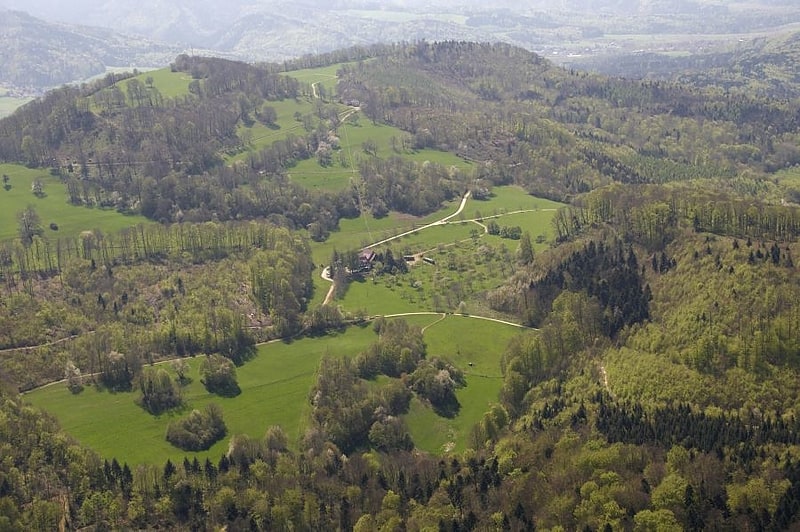
The Schönberg is located on the southern outskirts of Freiburg im Breisgau and at 644.9 meters above sea level the Hausberg of the municipality of Ebringen.[25]
Schlossberg
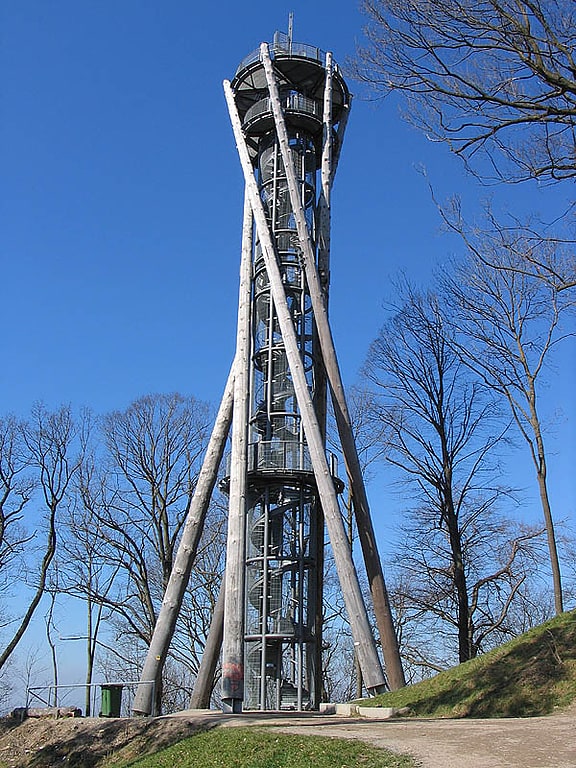
Hiking spot with panoramic city views. The Schlossberg is a tree-covered hill of 456 metres located in the area of the city of Freiburg im Breisgau. It is directly to the east of Freiburg’s Old Town and belongs to the Black Forest. The main geological fault is at the western edge of the Schlossberg, towards the Upper Rhine Graben.[26]
Address: What3words: ///manuals.stewing.tasters, 79104 Freiburg im Breisgau (Mitte)
Kartause
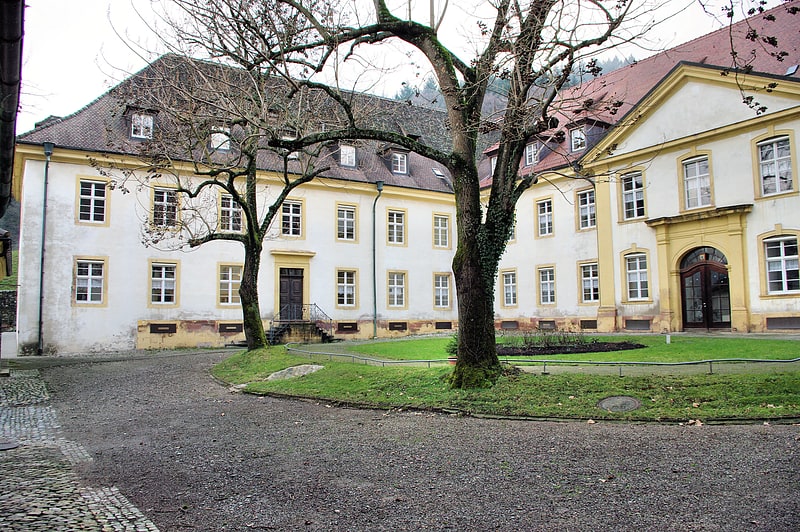
Monastery. Freiburg Charterhouse is a former Carthusian monastery, or charterhouse, in Freiburg im Breisgau, Baden-Württemberg, Germany.[27]
Kronenbrücke

The Kronenbrücke was built on the site of the original bridge which crossed the Dreisam and was one of the two oldest bridges in Freiburg im Breisgau, a city on the edge of the Black Forest in the Baden-Württemberg region of Germany. In 1869, an iron bridge with stone substructure replaced the original wooden bridge across the River Dreisam. This, however, lasted only three years due to excessive flooding and the replacement erected was Gartenstraßen. After extensive work was done to dams and shores to prevent the bridge collapsing in the manner of its predecessor and the building of two others, to reduce frequent stressing, the now renamed Friedrichsbrücke, named after Grand Duke Frederick, opened in 1903. Despite hopes of the bridge lasting for centuries, it was replaced due to a variety of reasons in 1962 with the removal of its base done in 1967, and final construction completed in 1969. The new bridge was the Kronenbrücke an oval-shaped twin bridge, enhancing traffic management and navigation on the inner city ring road. History was soon to be repeated as the current incarnation was unable to be modified to allow a planned tram line. The Kronenbrücke was demolished in 2015 to make way for a new economical bridge featuring a tram line. Its replacement, also called Kronenbrücke, has a simpler straight road guidance system which allowed a more economical bridge size.[28]
Platz der Alten Synagoge

Park in Freiburg im Breisgau, Germany. The Platz der Alten Synagogue is a square in Freiburg, Germany. With a size of 130 square metres, it is the second largest square in the city after Minster Square. The square is named after the old synagogue, which was destroyed during the Kristallnacht in 1938. The synagogue had been built in 1869/1870 to the southwest of today's location of the square.
The Stadttheater and the Kollegiengebäude II of the University of Freiburg are located on the square. To the south on Sedanstraße is the Platz der Universität, where the Kollegiengebäude I and the University Library are located.
From 1927 to 1939 and after 1945 until the 1980s, the entire area between Bertold Straße and Belfort Straße was named Werthmannplatz until the former synagogue site became Europaplatz. The Platz der Universität has been so called since 2007.
During the Rotteckring project, the square was redesigned in 2016. On the north–south axis, the street crossing to the inner city centre has been replaced by tram tracks and the previous lawn area replaced by continuous pavement. The newly designed square opened on 2 August 2017.[29]
Address: Platz der Alten Synagoge 1, Freiburg (Mitte)
University Church
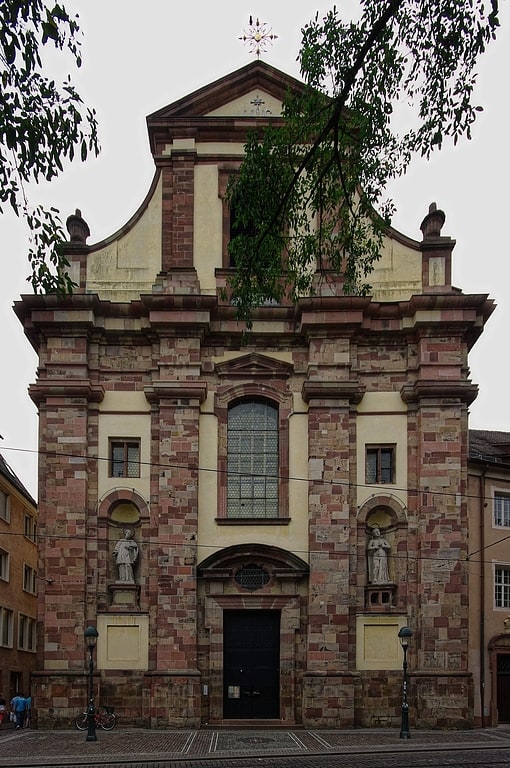
Also known as: Universitätskirche
Catholic church in Freiburg im Breisgau, Germany. The University Church, or Universitätskirche, is a Catholic church at the University of Freiburg. Located on Bertoldstrasse amongst the university buildings, the former Jesuit church has been part of the university since the 18th Century.[30]
Address: Bertoldstraße 24, 79098 Freiburg im Breisgau (Mitte)
St. Ottilien
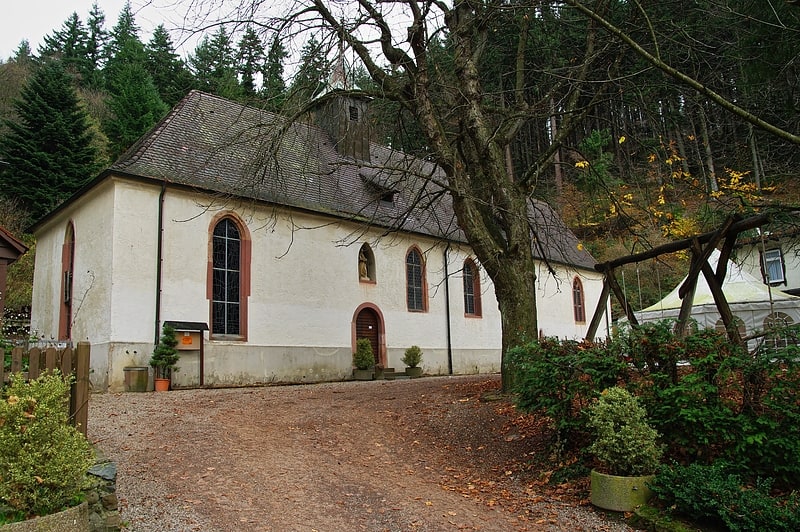
St. Odile is a forest sanctuary in Freiburg's suburb Waldsee. It is located at a height of 480 m in a forest clearing in the upper St. Odile ravine in the municipal forest of Freiburg at the southern slope of the Roßkopf at a distance of approximately 750 m from St. Wendelin.[31]
Address: Kartäuserstraße 135, 79104 Freiburg im Breisgau (Ost)
Cobblestone mosaics

Cobblestone mosaics can be found throughout Freiburg im Breisgau. Most mosaics are embedded in the cobblestone pavement of the city centre of Freiburg.[32]
St. Wendelin's Chapel
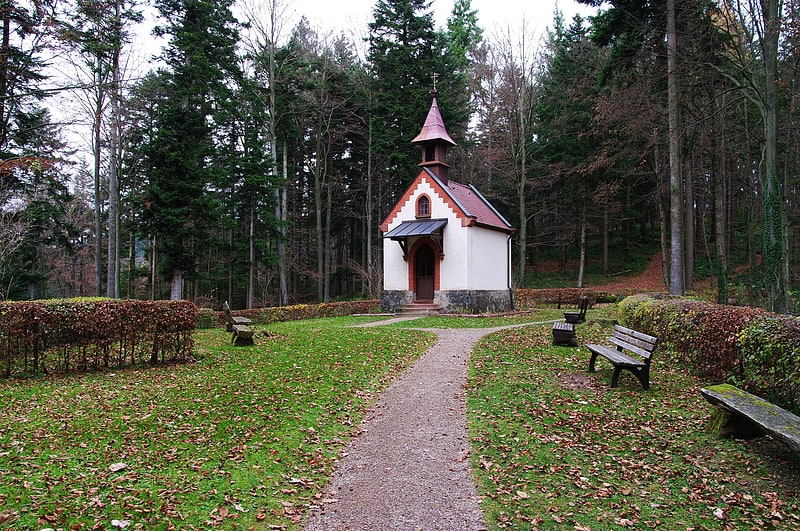
Also known as: St. Wendelin
Church in Freiburg im Breisgau, Germany. The small St. Wendelin's Chapel is located about 750 metres east of St. Odile above the Musbach valley, Germany, on the Small Roßkopf, a spur of the Roßkopf, at a height of 540 m. It belongs to the parish of St. Hilarius in Freiburg's suburb Ebnet. It is named after Saint Wendelin, a king's son who lived as a shepherd and hermit. Wendelin is the patron saint of shepherds and flocks. According to the documents of the Capuchins the first chapel was built of wood in 1723 and served the herdsmen from Ebnet also as a protection against storms. Pilgrims who went from Freiburg over the Roßkopf to St. Peter used this chapel as a shelter and for devotion. The present stone chapel was funded and built by the citizens of Ebnet in 1895. Even today it is maintained from Ebnet.[33]
Theater Freiburg
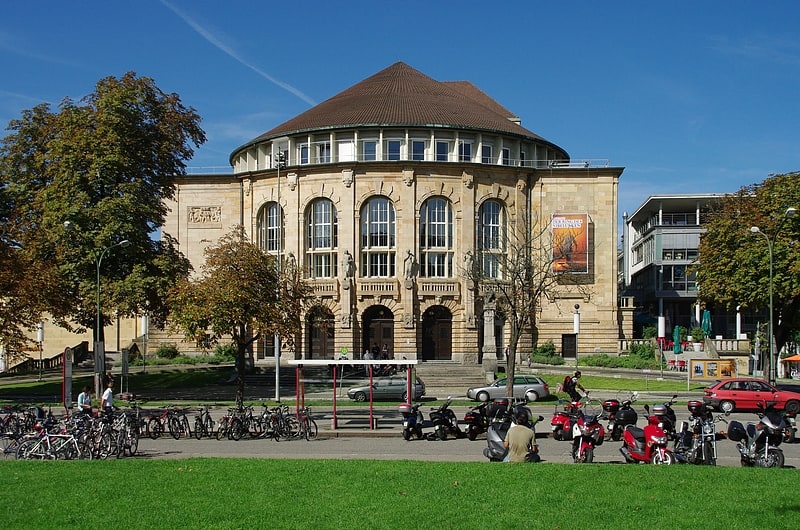
Theatre in Freiburg im Breisgau, Germany. Theater Freiburg is a theatre in Baden-Württemberg, Germany.
Freiburg Theatre, sometimes also referred to as Stadttheater Freiburg (Freiburg municipal theatre), formerly Städtische Bühnen (Municipal Stages) Freiburg, is the oldest and biggest theatre in Freiburg im Breisgau. It is located in Bertoldstraße, on the edge of Freiburg's historic city centre, and unites four venues under one roof: the Großes Haus (main stage), the Kleines Haus (small stage), the Kammerbühne (chamber stage) and the Werkraum (workshop). The Winterer Foyer additionally hosts author readings, such as the Litera-Tour, chambermusic concerts and evening lectures on current affairs, such as the Dream School series. Since September 2005 the theatre has been under independent ownership.[34]
Address: Bertoldstrasse 46, 79098 Freiburg im Breisgau (Mitte)
Freiburg Castle
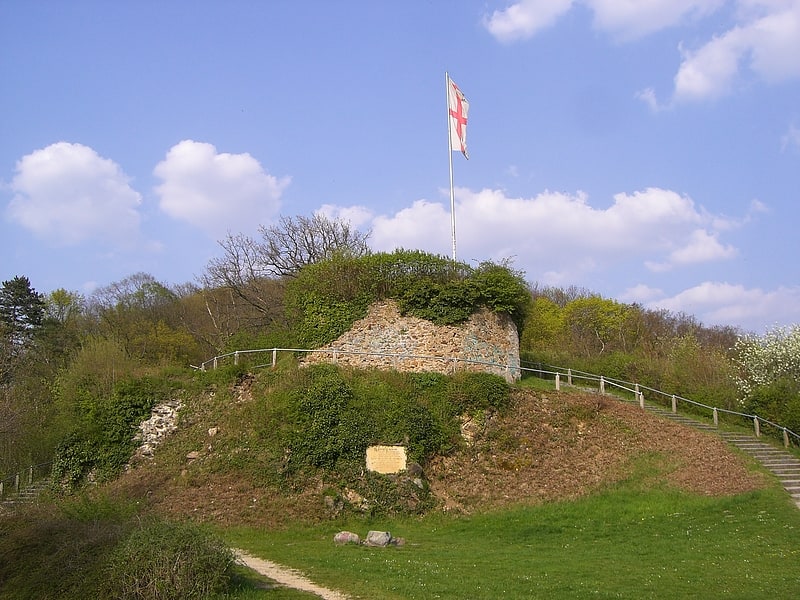
Also known as: Burg Freiburg
Freiburg Castle is a vanished castle. When it existed it was usually called the Burghaldenschloss.[35]